
SWITZERLAND: On October 29 Rhätische Bahn successfully ran a special service formed of 25 four-car Capricorn electric multiple-units to claim a record for the world’s longest passenger train. The event was staged as part of a series of celebrations to mark 175 years of railways in Switzerland, and in a bid to boost tourist traffic following the coronavirus pandemic.

The 1 906 m long train was operated over a steeply graded section of the 89 km Albula line from St Moritz to Chur, which is designated as a UNESCO World Heritage Site. The special departed from Preda at 14.20, 20 min later than scheduled, and crossed the 65 m high Landwasser viaduct near Filisur before completing its 24∙93 km journey at Alvaneu at about 15.30. Actual running time was around 46 min. En route the train traversed 48 bridges and viaducts and passed through 22 tunnels on the 1 000 mm gauge route.
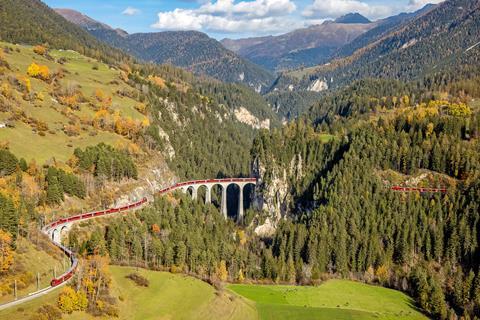
The 100-vehicle formation of Stadler-built trainsets grossed 2 990 tonnes. Regenerative braking was used to control the train on the downhill route ― the difference in height from the starting point to Alvaneu was nearly 790 m.
Speed was limited to 35 km/h, partly to avoid overloading the power supply system ― around 4 000 kWh were generated during the descent. Passage of the train was monitored from the RhB network control centre in Landquart.
On board the train were seven drivers, 21 technicians and 150 guests. Around 3 000 people watched the train from a dedicated festive viewing site near Bergün where the train halted for 10 min ― tickets for the event were sold out within a few days after they were offered for sale in early August.
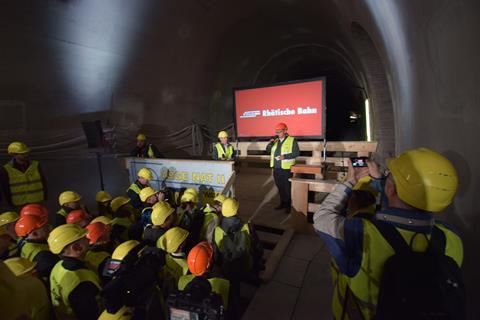
Complex preparations
Before the departure, RhB organised a press visit to the new Albula tunnel which is currently under construction parallel to the existing bore dating from 1903. The operator’s Head of Infrastructure Christian Florin reported on progress with the new tunnel, which is scheduled to open in summer 2024, while Head of Rolling Stock Ivo Hutter provided more details of the preparations for the world record run.
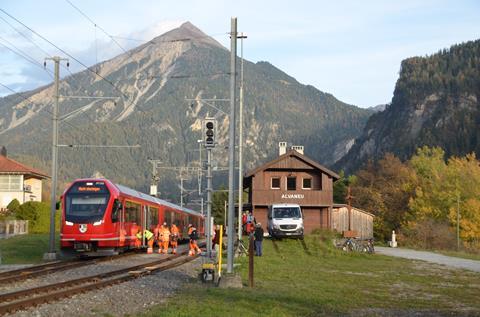
Several months of preparatory work and testing were needed ahead of the event. With the final tests completed, RhB assembled the 25 Capricorn EMUs on the evening of Friday October 28 in Samedan. Here they were programmed for the special run on the following day and coupled in sets of four; a field telephone was installed along the length of the train for communications purposes. The complete train was then assembled and positioned in the Albula tunnel ready for departure. About 400 staff were involved in the project during the day.
As the Albula route had to be closed for about 12 hours, RhB arranged a special timetable for regular passengers to and from the Engadin with some trains diverted via the Vereina route and others replaced by buses.
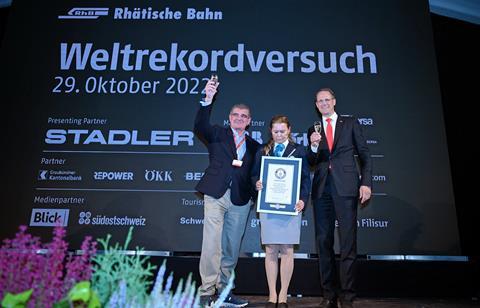
Once the train had completed its run, RhB Director Renato Fasciati.was presented with a certificate from Guinness World Records, certifying the record trip as the world’s ‘longest narrow gauge passenger train’.
‘After intensive preparation, we are overjoyed to have achieved this world record’, he commented. ‘Not only did we have a wonderful railway festival here in Bergün, but we were able to present ourselves around the world as a fascinating and innovative mountain railway, thanks to our dedicated partners, sponsors and an incredibly dedicated team. Fasciati added that people had come from all over the world to see the ‘amazing spectacle’.
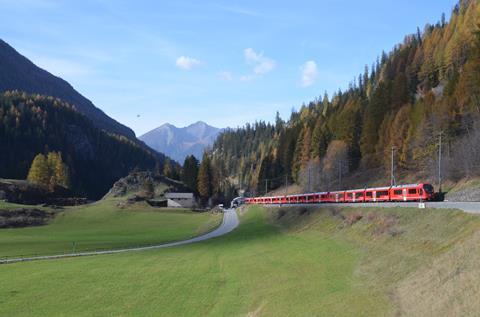
Sponsors for the event included Stadler Rail, track maintenance company Sersa, Siemens, Repower and ABB.
The previous record for the world’s longest passenger train was established on April 27 1991 when a 1 732 m long train formed of 70 coaches and a single Class 27 electric locomotive ran from Gent to Oostende in Belgium.
BHP Iron Ore set a world record for the longest freight train on June 21 2001 when it operated a 7∙3 km long train formed of 682 wagons between Yandi mine and Port Hedland in the Pilbara region of western Australia; hauled by eight General Electric AC6000CW diesel locomotives, that train had a gross weight of 99 734 tonnes.
















